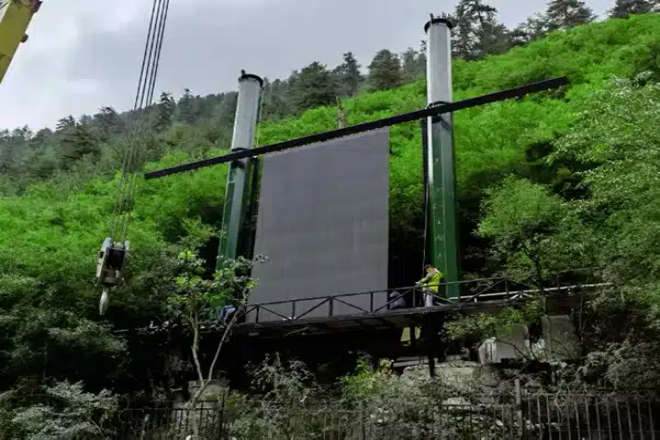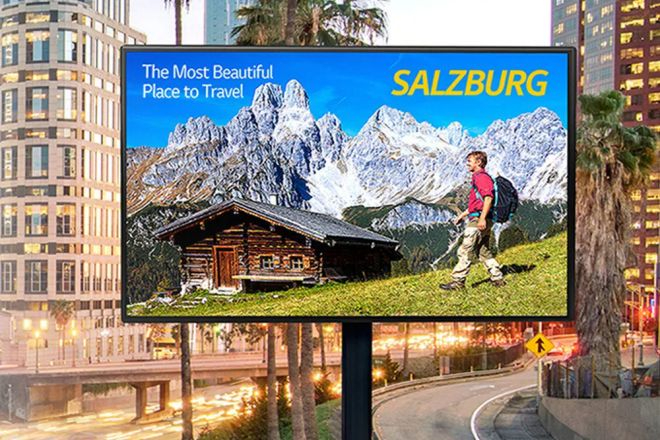介绍
Have you ever thought that there are countless wonderful stories behind those ancient city walls and mysterious ruins?
They are like treasures sealed by time, waiting for us to discover. Today, the LED显示屏 in scenic spots are like a magic key that can help us open the door to these treasures.
目录
1. Current application status of LED display screens in tourist attractions

1). Development History
LED display screens could only display monochrome text and numbers at first, and their functions were relatively simple.
Later, multi-color and full-color LED display screens appeared, and began to be used for advertising and displaying information, and the effect became better and better.
Later, the screen 解决 became higher and higher, and curved screens and 柔性LED屏幕 also came out, and the display effect became clearer and cooler.
2). Existing application forms
Nowadays, LED display screens have three main uses in tourist attractions: displaying information, advertising, and updating useful information in real-time.
At the entrance of the scenic spot or the tourist service center, the display screen will display basic information such as the scenic spot map, scenic spot introduction, and opening hours, so that tourists can quickly understand the scenic spot.
In terms of advertising, 酒店, restaurants, souvenir shops and other businesses around the scenic spot will use LED display screens to display their own advertisements to attract tourists.
2. Why use LED display screens to tell historical stories?

Historical stories may sound a bit boring, but LED displays can make stories vivid through cool forms such as pictures, videos, and animations.
For example, when telling a story about an ancient war, the screen can show pictures of soldiers charging into battle, coupled with shocking sound effects, which can immediately grab the attention of tourists and make them feel that it is beautiful and fun.
LED displays can not only display text, but also play videos and audios, and even allow tourists to interact through touch screens or voice.
For example, tourists can click a button on the screen to learn more about the details of historical figures or test their understanding of history through question-and-answer games.
This interactivity allows tourists to actively participate instead of passively listening, making learning more interesting.
The content of historical stories sometimes needs to be updated, such as the discovery of new archaeological evidence or new research results.
LED displays are very convenient. You only need to operate in the background to update the content and display the latest historical knowledge at any time.
Unlike traditional display boards, which need to be remade once updated, it is time-consuming and laborious.
The space in scenic spots is sometimes very limited, but LED display screens can show a lot of content without taking up space.
For example, a small screen can show many videos of historical stories, and tourists can choose which one to watch according to their interests.
This not only saves space but also shows more content, killing two birds with one stone.
People nowadays, especially young people, are used to using electronic devices to obtain information. LED display screens just fit this habit, making tourists feel familiar and friendly.
Moreover, by displaying historical stories on the screen, they can also be combined with social media sharing to let more people understand the culture of the scenic spot.
In short, LED display screens are like a “super story machine”, which can make boring history interesting, and can also allow tourists to better participate and understand, which is very suitable for telling historical stories.
3. Strategies for telling historical stories with LED display screens
1). Content design
In content design, the first thing to do is to pick the right story. You have to choose those historical stories that are closely related to the scenic spot, such as legends of scenic spots, historical events that have happened, etc.
If these stories are well-founded, they should refer to historical documents and preferably listen to the opinions of experts so that people can be convinced.
Then, these complex stories should be simplified and adapted into versions suitable for display on LED screens, and the plots should be told vividly and interestingly in plain language, so as to catch the attention of tourists.
Finally, don’t forget to use “big moves” such as pictures, videos, and audio, and even use animations to reproduce historical scenes so that the stories come alive as if they were performed in front of tourists.
2). Display method
When displaying, make full use of the dynamic effects of the LED screen and “move” the plot of the story through animation or video editing, which is more attractive.
You can divide a long story into several chapters and tell them one by one, leaving some suspense in the middle so that tourists can’t help but want to read on.
You can also design some interactive links, such as allowing tourists to operate through touch screens, listen to voice explanations, and even play question-and-answer games so that tourists can not only watch but also participate in them and their understanding and memory of the story will be deeper.
3). Technology application
In terms of technology, high-definition LED screens must be used, so that the picture is clear, the colors are bright, and the story looks more pleasing to the eye.
You can also use intelligent control technology to automatically adjust the playback content according to the number of tourists and time, and even use sensors to automatically play related stories when tourists approach the screen.
Of course, the most important thing is to integrate audio, video, and animation elements and use VR or AR technology to make tourists feel as if they have traveled back to the historical scene and feel the charm of the story in person.
4. Future development trends and prospects of scenic spot LED display screens

1). Technological progress
In the future, LED display screens will become more and more powerful. The screen resolution will be higher, the picture will be clearer, and the colors will be more realistic.
For example, new technologies such as MiniLED and MicroLED can make the screen thinner and more flexible, and can even be made curved or transparent, which is super cool!
In addition, future LED display screens will be more “smart” and can automatically adjust the brightness and color according to the surrounding light and the position of the audience so that tourists can watch comfortably in any environment.
These technological advances can take the dissemination of historical stories in scenic spots to a higher level.
For example, through high-definition images and intelligent interaction, tourists can experience historical stories more immersively, as if they were traveling back in time.
2). Cultural integration
In the future, scenic spots will combine technology and culture more closely. LED display screens are no longer simply “big screens”, but become a “cultural heritage artifact”.
Through the Internet of Things and artificial intelligence, scenic spots can achieve smarter cultural displays.
For example, when tourists walk near a certain scenic spot, the LED display screen will automatically play related historical stories and even combine AR/VR technology to make tourists feel as if they are in a historical scene.
In the future, the status of historical stories in scenic spots will become more and more important, becoming a “killer weapon” to attract tourists.
3). Sustainable development
While telling historical stories well, scenic spots will also pay more attention to protecting cultural heritage. LED display screens can play a big role in this regard.
For example, through high-definition display technology, scenic spots can display the details and historical background of cultural relics without destroying them.
Moreover, LED display screens themselves are becoming more environmentally friendly and energy-saving.
Future screens will use more environmentally friendly materials, consume less power, and be more environmentally friendly. In this way, the scenic spot can not only inherit culture but also protect the environment, killing two birds with one stone!
5. 结论
After reading this, do you think that the LED display is not just a screen but more like a “magician” who can tell stories?
It not only makes history vivid and interesting but also allows us to gain a lot of knowledge during the tour.
In the future, with the continuous advancement of technology, LED displays will bring us more surprises, allowing us to feel the charm of culture in every corner of the scenic spot.
最后,如果您想了解更多关于LED显示屏的知识, 请与我们联系。
